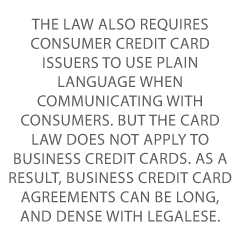Do You Know All of the Credit Card Terms You Might See On a Credit Agreement?
When you sign up for a credit card, whether business or personal, your signature on the credit card agreement signifies an acceptance of the credit card terms in that agreement. But what do all those terms mean, anyway?
Credit Card Terms and The Law
 Both federal and state law can apply to credit card transactions. In 2009, Congress passed the Credit CARD Act of 2009, more commonly known as the Credit Card Bill of Rights. One of the things the Act did was to allow for the creation of the Consumer Financial Protection Bureau.
Both federal and state law can apply to credit card transactions. In 2009, Congress passed the Credit CARD Act of 2009, more commonly known as the Credit Card Bill of Rights. One of the things the Act did was to allow for the creation of the Consumer Financial Protection Bureau.
The CFPB can and does hand out fines to card issuers if they violate the law. But the CFPB does not handle business credit cards.
The law also requires consumer credit card issuers to use plain language when communicating with consumers. But the CARD law does not apply to business credit cards. As a result, business credit card agreements can be long, and dense with legalese.
Business Credit Card Terms
So before you sign on the dotted line, let’s go over what a lot of those terms actually mean. This way, you can potentially save money now, and later, and make informed decisions about payments, perks, terms, and more.
Cardholder Agreement
Let’s start with a look at cardholder agreements. A cardholder agreement provides the terms and conditions of a credit card account. This agreement represents a binding agreement between card issuers and their customers. Changes in the cardholder agreement can be made, with written advance notice, at any time by the issuer.
It must include the annual percentage rate, the monthly minimum payment formula, annual fees, and dispute resolution processes.
Interest Rates
An interest rate is the price a lender charges for loaning money. But with credit cards, lenders can set multiple interest rates, and that can add complexity. For example, you may have a low, teaser (introductory) rate when you open an account, followed by a higher standard rate for purchases, which turns into a penalty rate if you pay late.
As a result, you may end up owing a balance to a credit card company with multiple interest rates.
Comparing Interest Rates
Interest rates on credit cards are expressed in a standardized way so you can more easily compare cards. That standard way is known as the APR, which stands for annual percentage rate. With credit cards, the interest rate is calculated on the basis of your average daily balance times the rate. Credit card interest rates are expressed in a standard way as an annual percentage rate (APR).
Annual Percentage Rate or APR
APR is a yearly interest rate that includes fees and costs paid on borrowed money (loans or credit). Lenders are required by law to disclose this. The rate is calculated by taking the periodic rate and multiplying it by the number of billing periods in a year.
A credit card may have separate APRs listed for balance transfers, cash advances or other special offers. If offers are subject to an expiration date, the relevant balance will usually revert to your default APR.
Default APR
But that’s not the only purpose of a default APR. If you are late in making payments, your standard APR may increase to a default APR. Default APRs may be applied to all outstanding balances on your credit card, if you are more than 60 days late paying the monthly bill. This is also called penalty rate.
Fixed Rate (or Fixed APR)
An annual percentage rate that does not change throughout the year. This is unlike an introductory APR that changes after a specific period of time. Note: fixed APRs will likely change if the Prime Rate changes. So it makes sense to pay attenti0n to financial news so you know if and when the Prime Rate changes.
Credit Limit
Let’s look at limits. Your credit limit is the maximum amount you’re allowed to borrow on a card. The size of a credit limit, and how much of it has been used, have an influence on credit scores. If you exceed the credit limit on a card you can be charged a fee.
Balance
Let’s pivot over to balances. On a credit card account or credit line, the balance is the amount owed. When a cardholder does not pay the monthly amount owed in full, and carries a balance over a monthly billing period, the card issuer charges for the privilege of borrowing. This is in an amount set by the card’s interest rate.
Balance Transfers
A balance transfer occurs when the outstanding balance of one credit card (or several credit cards) is moved to another credit card account. This is often done when looking for a lower interest rate. Many credit card issuers offer introductory balance transfer APRs that are lower than the standard rates.
But balance transfers usually have fees. A balance transfer fee is a fee charged by a credit card company to transfer a balance from one account to another. This fee is often a low percentage (often three to five) of the transferred amount.
Charge Card
But not all business credit cards allow for leaving a balance on the card. A charge card is a payment card that requires a full payment of the charge each billing cycle by the statement due date. Unlike credit cards, which give borrowers a revolving line of credit that can be accessed and paid down over time, charge cards do not allow you to carry balances forward. As a result, they do not charge an interest rate.
Credit Card Terms Concerning the Fees You Might Have to Pay
Minimum Payment
Credit cards often charge minimum payment amounts. The minimum payment is the smallest amount you must pay to keep the account from defaulting. To reduce debt more quickly, pay more than the minimum payment each month. And, at the same time, avoid adding any new charges.
Late Payment Fee
A late payment fee (a late charge) is charged to a borrower who misses paying at least their minimum payment by the payment deadline. In order to avoid late fees, ensure that you pay at least the minimum amount by the due date. Late payments may affect your credit history negatively, even if your entire outstanding balance is later paid in full.
In the consumer credit world, occasional late fees are capped at $25 under federal regulations.
Delinquent Account
Any account past due is a delinquent account. But in the consumer credit card industry, a card issuer usually will not report an account as delinquent, until at least 30 days have gone past the due date during which the cardholder has not made at least a minimum payment. In the business credit world, an account can go delinquent in one day.
Annual Fee
Another charge a business credit cardholder may encounter is the annual fee. This is a yearly fee banks charge for the privilege of using of their credit card. Annual fees can run to more than $500. Ideally, it’s best to use a card that doesn’t impose an annual fee.
There are cards which have introductory offers of no annual fee, but always check the fine print for what the yearly fee will be once the introductory period is over.
Foreign Transaction Fee
Another fee cardholders may need to pay is a foreign transaction fee (AKA foreign exchange fee). These fees are charged by many credit card companies on purchases made in a foreign currency, or on purchases involving a foreign bank (regardless of whether a foreign currency is used).
Usually, these fees are a percentage of the amount of each foreign currency purchase, with no minimum or maximum. Foreign transaction fees are charged by transaction processors like Visa and MasterCard. The card issuing bank may choose to pass that fee along to consumers. Recently, more issuers have dropped foreign transaction fees, particularly from their travel cards.
Credit Card Terms and Perks You Might Enjoy
Let’s look at some common perks.
Cash Back
In the credit card industry, cash back refers to a rewards program that returns to you a percentage of the total amount spent on your credit card over a specific period of time. This is often monthly. Surveys show that cash back is consistently the most popular form of credit card rewards for consumers. This makes sense, as cash isn’t restricted in ways other perks may be.
Sign-up Bonus
A sign-up bonus is an enticement offered by card issuers to consumers for applying and using a card. Sign-up bonuses have become generous recently. They can sometimes be for as much as 100,000 points. Often, the cardholder must earn the bonus by reaching a spending threshold in a limited initial period. For example, you may need to spend $3,000 on a card in the first 90 days after opening the account.
This spending threshold is called minimum spend.
Loyalty Programs
Another kind of perk involves being enrolled in a loyalty program. Loyalty programs are used to give cardholders incentives to use a specific card. Loyalty programs may have their own cards, called rewards cards, points cards, discount cards or member cards. For example, some airlines offer loyalty credit cards that grant their users discounts on flights if they meet cumulative spending goals.
Credit Card Terms About Who Can Actually Use a Credit Card
Let’s look at who can use a credit card.
Account Holder
A credit card account holder is the person or business responsible for paying the amounts charged. But you can let a person use a credit card as an authorized user, without them being legally liable for the debt.
Co-Signer
A co-signer is a person who signs an agreement to pay off a loan for someone else if that person defaults. Co-signing is a technique often used among family and friends to let a person with good credit vouch for someone with new credit or bad credit to get a loan. This can also be helpful for a new business owner with no business credit built yet.
The presence of a co-signer makes lenders more willing to approve loans for high-risk borrowers.
While co-signing allows the person with bad credit to get a loan, it puts the person with good credit on the hook for the entire amount borrowed. CreditCards.com polling data shows that in the consumer credit world, 4 in 10 co-signers end up paying at least part of the debt.
Guarantor
A guarantor on a credit card account is a person who signs an agreement to pay off a loan for someone else if that someone else defaults. It is similar to co-signing; in that it is a technique often used among family and friends to let a person with good credit vouch for a person with new credit or bad credit to get a loan.
The presence of a guarantor or co-signer makes lenders more willing to approve loans for high-risk borrowers. And like a co-signer, the guarantor is on the hook for the entire amount borrowed. Guarantors are treated differently in the collections process when a loan defaults, the bank first must exhaust other means of collections before turning to the guarantor.
Authorized User
An authorized user is any person who has permission to use a credit card account, but is not responsible for paying the bill. Authorized users differ from joint credit, in which both parties are obliged to pay. In some cases, the user will receive a credit card in his or her name, even though it is linked to someone else’s account.
Joint Credit
Also called a joint account. Here, a credit card is equally shared by two or more individuals. Parties involved all share the associated rights and liabilities of the credit account and are regarded by law as co-owners of the account. This means that if anything happens, such as defaults or fraud, all parties are affected.
Being a joint credit holder is different from being an authorized user. An authorized user has permission to make charges to a card, but is not responsible for payment.
Credit Card Terms About Getting a Credit Card
Let’s look at some of the terms that surround the process of getting a credit card (business or personal).
Credit Inquiry
A credit inquiry is created when a lender pulls someone’s credit record. It creates a record in a credit report of each time the borrower, a lender, or a potential lender gets a copy of the credit report. Credit inquiries, especially multiple inquiries, may negatively impact credit scores.
Hard Inquiry
This is an initial step lenders take in checking loan applications. The potential lender checks the business’s credit report. This has a small negative impact on that credit score. An occasional hard inquiry has only a small negative impact on a credit score.
Hard inquiries stay on a credit report for two years. What hurts a credit score most are multiple hard inquiries over a long period, which the credit scoring algorithms treat with suspicion, since they could signal hard times have befallen the borrower. It’s also known as a hard pull.
Soft Inquiry
This is a credit report check that does not impact the borrower’s credit score. Also known as a soft pull. Soft inquiries as a rule come from evaluations that don’t result in the granting of credit. For example, consumers can check their own credit as much as they like without it affecting their score.
Other examples include periodic checks by existing creditors and credit information pulled by insurance companies in the course of deciding whether to offer insurance.
Handling Problems in Your Credit Reports
Let’s add one more term you’ve probably heard us use.
Dispute
If you notice an unauthorized transaction or disagree with a charge on your statement, you can dispute it with your card issuer. In the consumer credit world, the issuer typically has two billing cycles to resolve the dispute. In the meantime, you may receive a temporary credit for the disputed amount. Credit issuers will want to see proof backing up any dispute.
Takeaways for Steering Clear of Expensive Surprises Hiding in Credit Card Terms
Consumers are protected with plain language requirements for personal credit agreements. But those plain language requirements don’t apply to business credit agreements. Interest rate details change depending on whether the APR is introductory or fixed. People who can use a credit card are defined by their roles and responsibilities, such as co-signer or authorized user.

